It all started two years ago, back in June 2014 almost immediately after I crossed the finish line of the same race in 8:58 placing 15th overall. It was my first 100k. It was the hardest race of my life and thought I would never experience such a hard time again. God, I was so wrong….
- Rambling
One of the common trait of a dedicated runner is perseverance:
continuing a course of action without regard to discouragement, opposition, obstacles, or previous failure
The biggest failure to me, after a DNF (did not finish) is a DNS (did not start). I was forced to take that option last June 2015 because of a stress fracture, leaving my friend Derek whom I dragged into ultra running, racing alone. So instead of looking for a replacement A-race, I chose to stick to Takayama, and designing a training and racing calendar solely and entirely focused on that event. I had never planned an A-race so ahead of time. 18 weeks was my longest, and with 16 months this time around I had time to accumulate training, stress and high expectation.
I believe the main components of a good training are patience, dedication and … passion. Patience because one needs to build up fitness very slowly, baby step by baby step, and being able to see the big picture of the training, to be able to step back and being able to see the forest and not just the tree. Dedication because, well, we cannot improve without work and hardships, obstacles and failures, it is part of the process. If you have a goal, you need to get things done, period, and running is a perfect example, you cannot cheat that fact. Recently the “no pain no gain” expression is getting a bad reputation, people want to believe that an easy path is always out there. I personally don’t believe in that and think it is a massive BS. You want ambitious results, you have to work hard towards it. Just my view. Finally, passion, simply because I believe it is the love of what you do that will carry you through the hard days. Patience will not last if you don’t love what you do. Above racing, I love the whole building and training process, to be process-oriented rather than result oriented (ok results has a big place for me… ). It is this passion that makes me embrace that suffering and makes me appreciate the beauty of the forest.
Grind, Ice cream, and everything in between
Note: this section deals with training and technical boring stuff, if you’re not interested, feel free to skip this part
During these 16-months macrocycle, I periodized a 4 x 4-months mesocycle, each ending with a B-race, two 50k races (here and here), and a 58k race back in March 2016 (Oshima Ultra marathon). Within each mesocycle a certain aspect of training was more emphasised with the last one being the most specific to the A-race. Beginning with more of a speed and power oriented aspect of the spectrum, and ending with a more endurance oriented for the final mesocycle. And just like with most running program out there, a one-week microcycle of 3 easy days, 3 hard days, 1 recovery day with a frequency from 6 runs to 10 runs, a weekly mileage from 90k to 170k which translated to ~ 5h to 12h per week of running. Easy runs were either by feel or by MAF, outdoors, rain, shine, snow or typhoon. During the entire macrocycle, hills were always present, either on the treadmill or during the long run, or for most of the time, both.
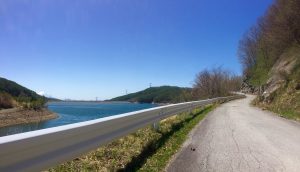
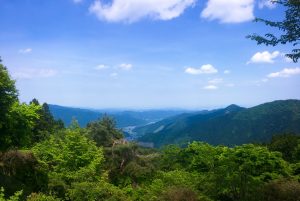
The weekly hill work on the treadmill was always the hardest, by far. Let’s speak the truth, I simply hate it. I spend usually 80min running, puffing and sweating like a pig on a steep inclined treadmill (between 8% and 14% incline). I started with shorter and faster reps – e.g. 2 sets of 10 x 1min -at the beginning of the cycle and ending with 4 x 12min as I got closer to my A-race. I hated that but I sucked it up because I know that it’s part of the process. I followed the same principle for the weekly speed session on a pseudo-track of 1325m.
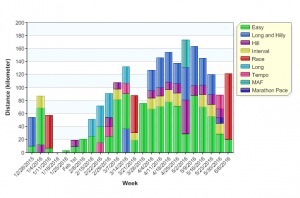
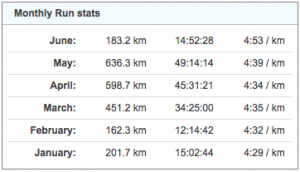
The weekly long run was what I was looking forward to every week. I can’t recall how many times I said that I love going out there in the mountains and running long and hard on the hills, alone or more recently with friends, anywhere between 30k and 60k. It was for me the reward of a hard week of training (I know, it doesn’t make sense, how can a brutal long hilly run be a reward…, I don’t know, this is how just I feel, I just love running up and down a mountain road very hard, once you reach the top, it just feels so freaking badass !!! ). I had my biggest week 5 weeks out with 172k that included a 3 days back to back to back hilly long runs (25km, 27km, 50km) in a training camp format in Yamanashi with three of my friends also preparing an Ultra.
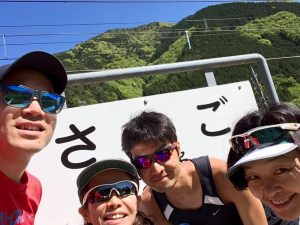


From there it was a very slow a gradual taper until D-14, where it then became an exponential taper pattern.
On top of the running I would add twice a week a 30min ~ 45min whole body strength training session. I am a firm believer of strength training for endurance athletes. Running is a repetitive movement and muscle imbalance tend to be magnified in the process. Strength training allows me to keep my body balanced, improve my running economy and is one of the biggest contributor of reaching a high mileage. My recent certification as a strength and conditioning trainer helped me consolidate all the knowledge I’ve been accumulating over the past few years.
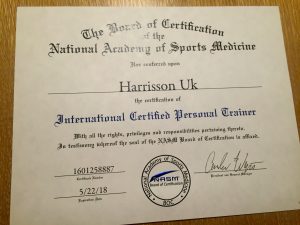
Then, the last piece of the puzzle was the body weight. At the end of March I was 61kg~62kg. I know my racing weight is 56kg, so more than 5kg to loose in less than 12 weeks from the race which means a bit more than 500g per week. Some people reduce the beer, I had to reduce the ice creams and chocolates. Back into calories in minus calories out, old school. The equation although flawed works pretty well. It tends to fail in practice because we tend to overestimate the calories out and underestimate the calories in. I have a good sense of estimating the energy content of any food put in front of me. However, when it comes to running, I’ve always trusted the estimation given by 99% of the web recourses out there that basically says that if you run on a flat course, with little to no wind, then you burn about your bodyweight times the distance traveled (e.g. if you weigh 60kg and run 10km, then most calculators online will say you burnt 600 kcal). The formula is wrong because it doesn’t take into account the effort level, that is the percentage of your maximum oxygen consumption you are using (for the Otakus out there). Racing a 10k or jogging a 10k will yield different result in terms of calories per minute. In other words: the more fit you are the less calories you burn. For me, it means that Strava overestimated by 100% (double !) and Garmin by about 40%. So a 10k run would burn only about 400kcal in reality instead of 620kcal from Garmin and 800kcal from Strava. With that in mind, I was able to loose weight as planned, weighing myself every morning and taking a 7-days moving average as a benchmark.
Note: What it means concretely for you. If you find yourself running easy at a 4:30 ~ 5:30 pace, then you should take at least 30% off the number of the estimated calories given by your Garmin (or any major online calculator out there) or if you use Strava, up to half the number !! (Sorry, but true story)

The dieting was the hardest during the final week where my volume was reduced drastically to about 20% of my peak. When you combine dieting and exercise, your metabolism decreases, and if you reduce exercise your appetite initially increases, so in order to maintain your weight or in my case to keep shedding the last few pounds I had to reduce my food intake even more. So from D-7 to D-2 I ate only once a day, skipping breakfast and lunch, focusing on healthy carbs (sweat potatoes, bananas, kabocha) and some protein (canned sardines and boiled eggs). Two days before the race, my 7-days average weight reached 56.1kg. Then from Friday to Saturday early evening, it was back to three meals, mainly carbs. Then last but not least, as usual I stopped all source of caffeine from D-10.
Finally, as I knew the temperature was going to range between 17 and 30degrees I started doing 15min to 20min sauna sessions 3 times a week from D-14 in order to get a bit heat acclamation.
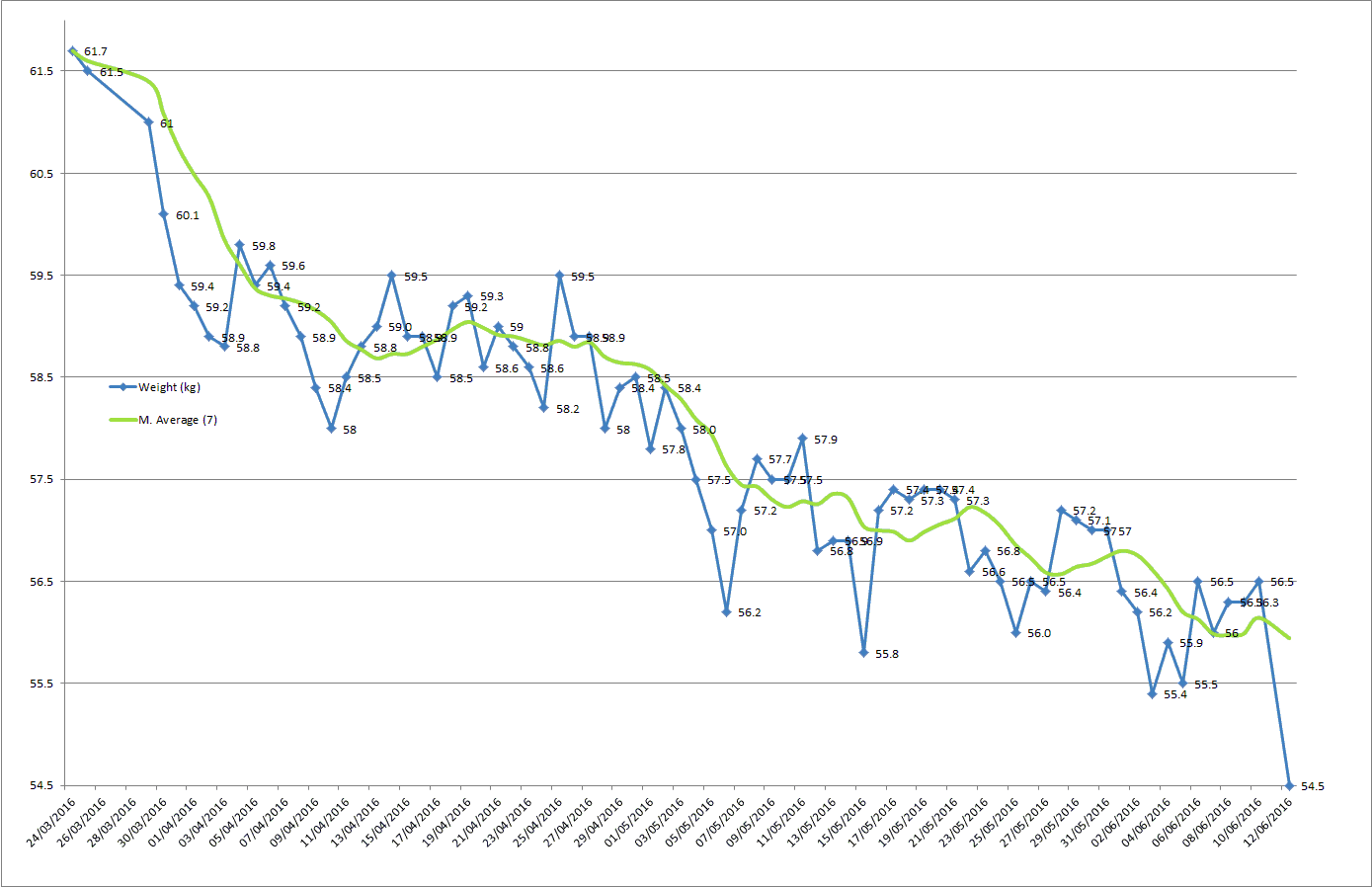
Impossible
- Pre-race
For a description about the race, you can read Derek’s last year’s report. The event getting more and more popular, the race actually filled up before the deadline. The day before the race I met Brett who was in charge of the English briefing session at the expo. He gave me a 10min private session (instead of the scheduled 60min), it was nice to see a familiar face.
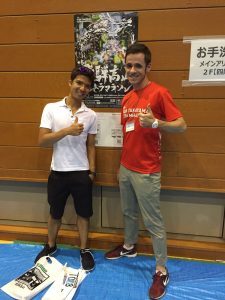
The race starts at 4:45 AM, I went to bed at 9, and woke up at 2:30 to eat my breakfast, 400kcal of simple carbs (banana and mochi). I packed up 5 non-caffeinated gels, for the first 50km, then I gave my wife Celine five other caffeinated gels for her to pass me at the 57km aid station. Lined up about 15min to go, with a Gladiator-like type of music played in the background by the organizers we were pumped up and excited to go. As usual I still saw lots of people jogging, and running around as a warm up. I just don’t understand the concept of warming up for a 100k race, it’s beyond my definition of logic.
As for my goal(s): my dream target was to do a sub-8 (4:50 pace), that would pretty much guarantee me a top 3 placing. My plan B target was to be top 6, as this would put me on the podium.
- The wall
After the usual countdown, the run went off. I started with a conservative pace, wearing my HRM to make sure I don’t go too hard, my HR was just between 0 to 5 beats over MAF. And as usual, during the first 30min, some runners around me were running like if they were racing a 10k, again it is beyond my comprehension.
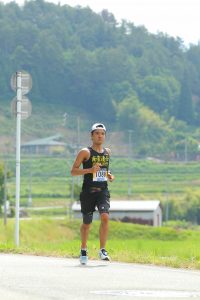
I started the race at about 20th place, then until the first climb at 16k, I passed maybe 2 or 3 runners. From there until the second and longest climb up to 40k, I passed probably around 10 runners. There was a sign at the marathon mark, 42.195km which I passed in 3h21min. I then reached the 57km aid station where I saw Celine, I was feeling good, I mean really good ! I was 8th at that moment and I was confident I’d be able to catch at least two other guys. Celine passed me the 5 last gels I gave her before the race. I took a sip of water and immediately took off.
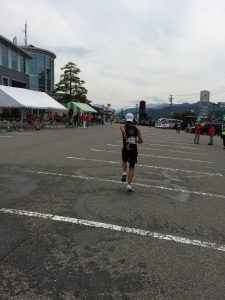
I shortly passed one runner after about 1km. Then on my way to the top of the very steep (about 15% incline) second mountain leading to a shrine, I passed another one. I was 6th. He was surprised to see me running the hill that hard and fast at this stage of the race. He was alternating walking and jogging. My will and determination when I passed him were at their peak. I felt invincible. I thought about all the mountains I climbed during my training. It paid off. I had goosebumps when I passed him. I felt superior. I was kicking ass. I was ready to climb the infamous stairs that were waiting for me at the top of the hill and eager to find the 5th runner. I was on pace to run a sub-8. My average pace was still below 4:50

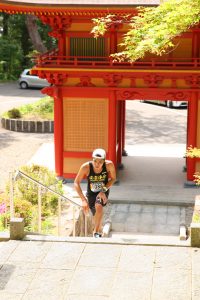
Before the race, I had a conversation with the coach who spoke those words
So to race well its the 60-90k section that needs to be the real focus – the big climb and descent before then is what will sort out the wheat from the chaff but that wont necessary become apparent until the 70-80km mark when all those who either went too hard up the hill or too fast back downhill will fall apart – just make sure you aren’t one of them!
He was so damned right. I engraved those words in my mind, my weekly long runs in the mountains gave me confidence about my strength and my perceived rate of exhaustion. I was at 63k mark, on the top of the hill, ready to tackle the very steep descent. My quads were sore and tight but manageable, I was running down at about 4:30 pace. The pain was in control as it had been since the start. The downhill continued until 70k. A few months before, Derek sent me this link about the dos and don’t from top ultra athletes. Most of them are very common sense to me, but one in particular got stuck in my mind. It goes like this
Do expect something to go wrong. No matter how perfect your training has gone, this is ultrarunning and a lot of crazy things can happen when you are running for hours on end.
I always thought of the infamous wall as a pure physical phenomenon, in the sense that you helplessly slow down because your legs have no more energy. I had never experienced a full blown bonk, a massive Wall physically and emotionally. The guys who went out too hard during the first 60k.. well…I was one of them. Tough and cruel reality. I am the only one to blame.
From 70k, it was a gradual uphill until 90k. It suddenly became very hard to just maintain a sub 5:00 pace, my speed ineluctably decreased little by little and my legs were getting more and more tight and sore, the type of pain that goes totally out of your control, it came so suddenly just like a slap in the face. A little glimpse at my Garmin showed a 5:20 pace. I was at the 73k mark, at an aid station. I stopped to get a gel and some water. I was in pain. I was in trouble. I was hitting a wall. A big wall. I tried to stretch. I started with my left calf, so I took a split stance with my right leg forward. But then my left quad seized up and was starting to cramp. I stopped and tried to stretch my left quad, standing on one leg, but then it was the turn my right foot and right calf to cramp. I just realised that I simply could not stretch without cramping another part of my legs.
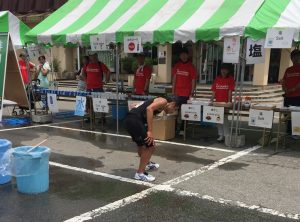
I tried to walk fast. It was relatively pain free but the watch was showing 8:40min/km pace. The situation was the following: I could either DNF, walk pain free and say good bye to my target, or run in an excruciating pain the remaining 27k knowing that my legs could give up at anytime. I didn’t hesitate, it was painful but I kept running. Suddenly the runner I passed during the climb earlier caught me back. He was probably running 10s per km faster than me. I was running at 5:30 pace, which was already so painful. I was back to 7th place. And I saw him, helpless, getting very slowly further and further away from me. It felt like in a bad dream where you are chasing an uncatchable target no matter how hard you run.
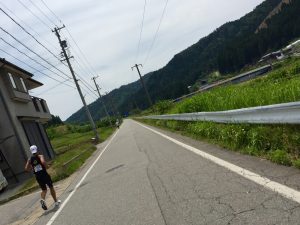
- Death before DNF
Then a car passed besides me. It was Celine. She screamed “go go go babe”. I could not respond. Then she asked me “babe, are you ok?”
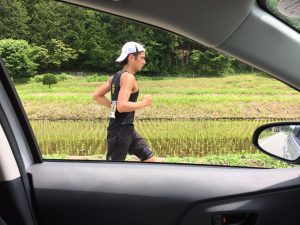
It is hard, it is very hard, it is so hard, my whole body is in pain, I still have almost 30k to go, my legs are barely responding, I’m don’t know if I’ll be able to finish… I don’t know what to do
When she saw that my voice was trembling, on the edge of crying, she realised how desperate I was. The situation had changed. Neither of my goals were reachable anymore. Then I thought, why fighting? why enduring all this pain? I could easily finish the race by just walking the rest and stop the torture now.
No I could not. It is contrary to my principles, it was the opposite of my values, it would be a disrespect to myself for all the training I’ve done, a disrespect to Celine who always comes by my side and supports me wherever I go. Walking would be a symbolic DNF. That’s impossible. Now that the podium had escaped from my hands, the ranking didn’t really matter, nor the time. But … I know that I cannot look at myself in the mirror if I don’t try my best and That really mattered! If I loose one, two, three, ten places because I walked, because I gave up, I would regret it. But if I give everything I’ve got, absolutely everything, then it doesn’t matter what my final result will be. I would know that I fought the best I could. That I gave my all. So I kept running, I kept looking ahead, eyes on the endless road, an infinite 25km. I couldn’t stop because I knew my legs would not let me run again.
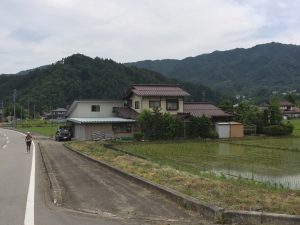
Every kilometre was harder and harder. I didn’t look back, I never did. I didn’t because I feared to see someone catching me. I used that fear to help me push beyond my limits and reach the boundaries of my physical capabilities. I came back to the fundamentals, one foot in front of the other, again and again and again, step by step. I eventually reached 90k, start of the final downhill stretch, 10k to go, a short run usually, an eternity that day.
- A teardrop
5k to go, my body was screaming “stop”, my mind and spirit were crying “never”. The battle between me and my legs, the battle against myself was soon over. 400m to go with a last small climb, it’s only one single lap around the track but it felt like ten.
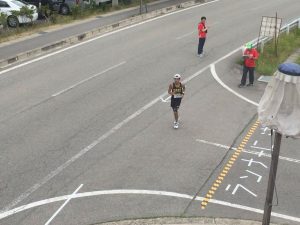
Finally, a few seconds later, the tape was within my sight. I thought I would never see it. Never had a finish line felt so hard to reach. After all these years of racing, I thought I’d seen almost everything my body could give. That day proved me just the opposite, I just knew nothing about myself, my limits and running. I still have a ton to learn. The road is still very long. Just like my good friend Derek said so well, life is an Ultramarathon.
An unexplainable very deep feeling suddenly took hold of me. As I broke the tape, my spirit could finally let go, reuniting with my body again. The war between the two, my body and my mind finally came to an end and I was able to find peace again. Unexpected tears then appeared on my face, a visible deep expression and manifestation of my soul.
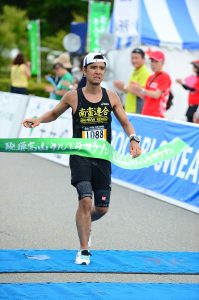
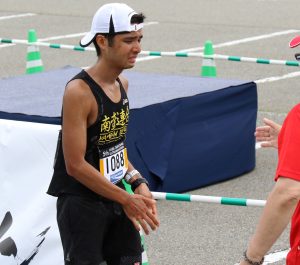
I missed the podium, but I’ve gained and learnt so much more in exchange. It is by far the greatest sense of accomplishment I have ever felt. Not only have I found new boundaries within me, but mostly, numerous messages received from friends gave me a more profound meaning in what I’m doing: beyond the congratulations, I was cited as a source of inspiration. That, is the sweetest victory I could ever hoped for.
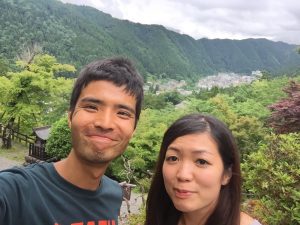
Race stats
Final finishing time – 8h 36m 07s
Placing 7th of 1952 starters
Average pace – 5m 07s /km
Average cadence – 185 steps per min
Max elevation – 1,345m
Elevation gain – 1,789m (Garmin)
Min/max temperature – 17/32 degrees Celsius
100km winner’s time – 7h 33m 20s
100km finisher rate – 71% men and 68% women
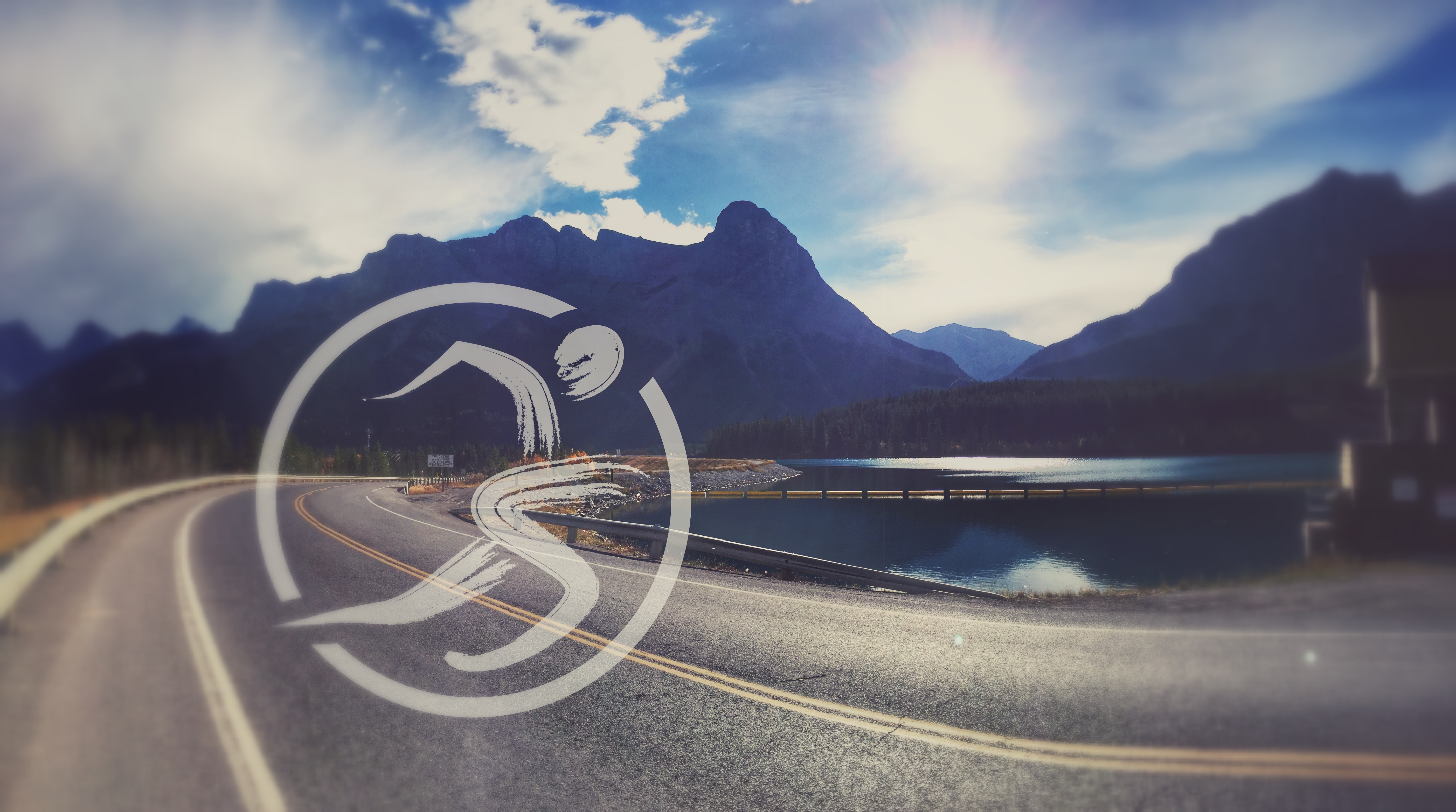

Well, now you can say you’ve been to hell and back, and really mean it. Welcome back. Hope the next one won’t be so difficult.
BTW, this capcha thing is a real pain in the ass.
Boy, it’s uber-badass!
Hitting the wall is really something, It happened to me so many times when I was under trained for marathons, and I know those tears at the finish line. Agree with Derek life is an ultra and the beauty of it is that there is always a higher wall ahead of us.
And what a report! I read it twice! First without clicking the links and a second time with the links!
Thank you for the inspiration as always
Bob, thanks a lot, sorry about the capture thingy :S
Philippe, I am super flattered you read it twice ! I remember this is not the first time you read my posts more than once, and it’s a real honor.
I hope to continue this path for a while. Waiting for the day you swim/bike/run your first IM !
Great write up! I can relate a lot of to what you wrote. My plan was to run a very conservative first half and then push hard after 70k. I ended up barely holding on after hitting a wall around 75k, which was frustrating. Maybe that’s just par for the course, but I think I may have run a bit too aggressively in a few places (maybe bombing down the hills too fast). I suppose this is the nature of ultra-running – easy to get excited and very hard to predict what is going to happen. Anyways, congrats to you – inspiring stuff.
Hi Jeff !
Thanks a lot for reading or for your comments.
I agree, although it was my second time, I felt I was just like my first 100k.
So many unpredictable stuff can happen during such a long event than plans become merely just a “suggestion”.
Congrats to you too on your first 100k, and I hope your second wont be as painful as mine 🙂
I wrote up a race report here if anyone is interested:
https://jeffsrunningglob.wordpress.com/2016/06/23/hida-takayama-100km-race-report/
“Everyone has a plan until they get punched in the mouth.”
-Mike Tyson
Bravo, Harrisson.